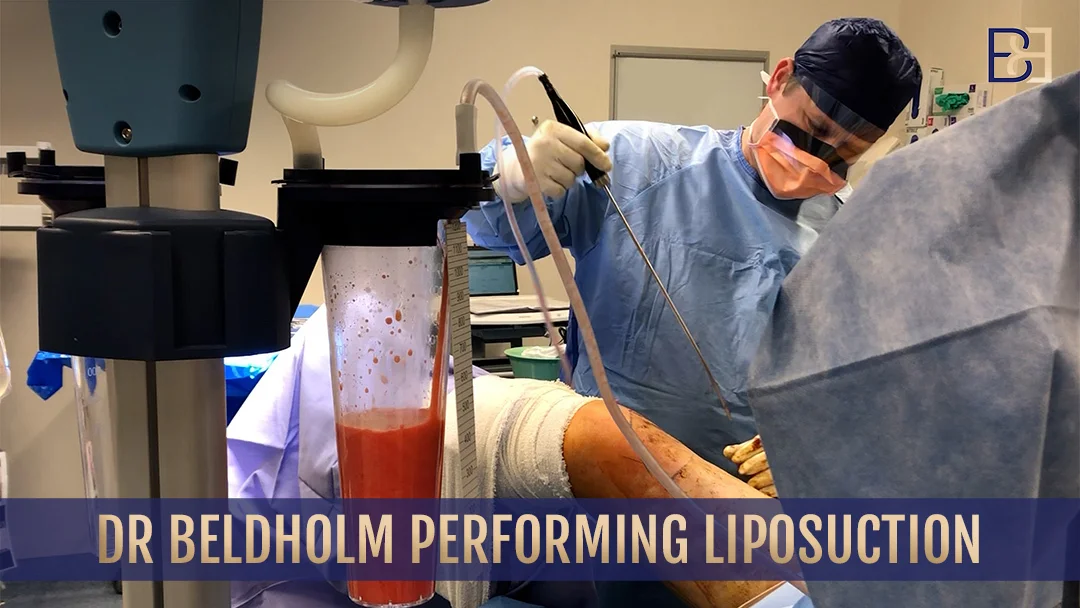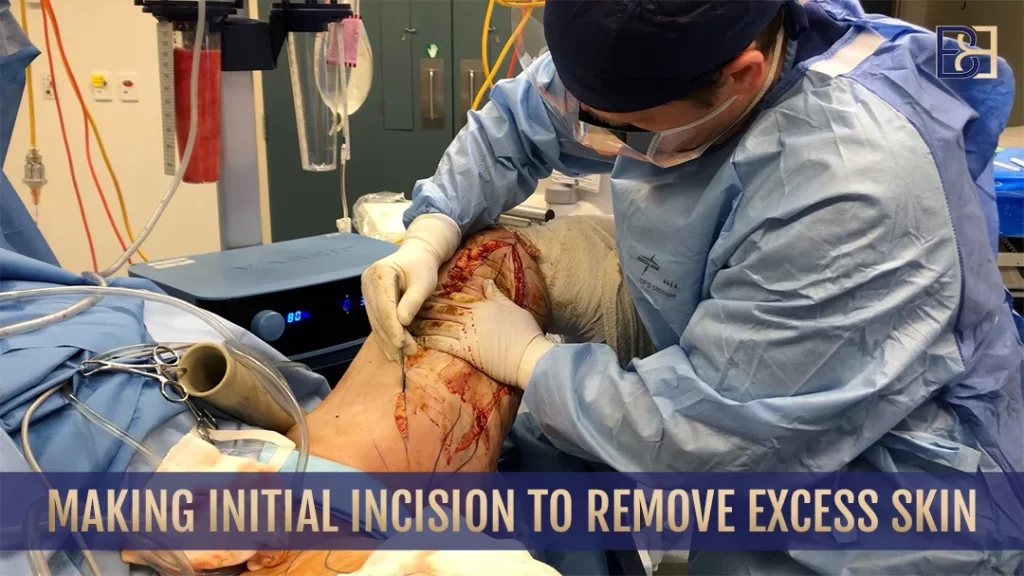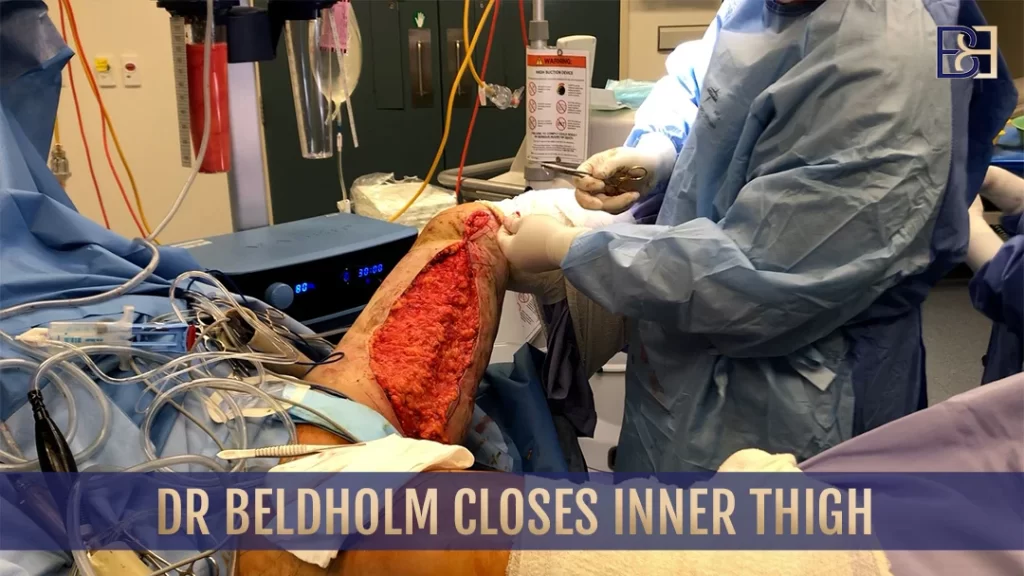Weight loss is a great accomplishment. However, many people have loose thigh skin after weight loss. There may be stubborn knee and thigh fat as well.
This article explains how a vertical thigh lift operation surgically tightens the inner thighs. You’ll also find out how VASER lipo can get rid of inner thigh fat for even better leg sculpting during thigh lift surgery.
Many of your thigh lift questions will be answered in this article. You will learn about different kinds of thigh lifts, how the operation works, what to expect in recovery, benefits and risks, who is a good candidate, and what the inner thigh lift scars look like.
Book your appointment online now
What is a thigh lift?
A thigh lift is a surgical procedure that slims and tightens saggy thighs after weight loss. The procedure involves cutting off the extra skin and fat. It is usually reserved for patients who have lost significant weight and need to remove loose skin.
What are the benefits of a thigh lift?
Some benefits of an inner thigh lift may include:
- Firmer, smoother thigh skin
- Slimmer upper legs
- Increased mobility
- Clothes that fit better
- Less discomfort from inner thighs rubbing together
- Reduced thigh irritation (such as thigh chafing and rashes between skin folds)
Types of thigh lifts
The first step is deciding what kind of thigh lift you need.
Mini thigh lift
Also sometimes called a crescent thigh lift or limited medial thigh lift, it ** the upper inner thighs only. Skin tightening is minimal with a short scar near the groin.
Vertical inner thigh lift
Also called an elongated medial thigh lift or full thigh lift, it focuses on the inner thighs from the groin all the way to the knee.
Outer thigh lift
Also called a lateral thigh lift, this procedure tightens skin on the outer thighs.
Thigh Liposuction
A thigh lift and liposuction pair beautifully. It is ** (and often recommended) to have a thigh lift with liposuction at the same time. However, if you are only concerned with inner thigh fat (no loose skin), you may need thigh liposuction only. Doctor Bernard strongly prefers VASER liposuction over traditional lipo.
What thigh lift is most common?
Since post-massive weight loss patients often have significant laxity on the inner thigh from the groin all the way to the knee, the vertical inner thigh lift will be the topic of this article. However, you will still find the information useful even if you need a different type of thigh lift.
Who is a good candidate for thigh skin removal surgery?
A thigh lift is great for tightening saggy skin and fat reduction. Not everyone is a good candidate however. You need to reach a healthy weight first. You should maintain a healthy weight for six months.
Smokers and pregnant women are not eligible for surgery. If you are willing to quit smoking, you may be a candidate. The ideal patient is in good overall health and has realistic goals.
If you’re not sure if you qualify for a thigh lift, you can find out by booking a 1:1 consultation with Doctor Bernard. During the consultation, he will take photos from different angles and discuss your medical history and risks. For most ** people, it’s a low-risk procedure.
Operation Guide: Thigh Lift Surgery with VASER liposuction
Learn how Dr Bernard Beldholm performs an inner thigh lift operation to tighten loose skin and reduce thigh fat with skin removal and VASER liposuction.
Phase 1: Surgery Preparation
Pre-operative markings
Before the operation, Doctor Bernard will meet you in the anesthetic bay at the hospital. He will go over any last-minute questions you might have. He will then draw markings on your inner thighs to plan the surgery.
Positioning you on the operating table
You will lie flat on your back for the operation.
Anaesthesia
For your ** and **, a thigh lift is done with general anaesthesia through an IV. You will have no pain or memory of surgery. Once you are fully sedated, a tube will be inserted to help you breathe. A licensed anaesthetist will oversee you during the operation and monitor your vitals.
Phase 2: VASER Liposuction
He will discuss the extent of thigh fat reduction with you to ensure you ** about your legs when your surgery is done.

What is VASER liposuction?
Doctor Bernard performs VASER lipo as the first step of the operation. He prefers VASER instead of regular lipo for several reasons.
What are the benefits of VASER lipo?
VASER melts fat, so it turns into liquid. Then the fat is removed with suction. While melting the fat first adds extra time to the operation, Doctor Bernard finds it gives ** results.
VASER benefit #1
During a thigh lift, his goal is to minimise trauma to your body during surgery. VASER is tissue selective. It mainly targets fat cells. This reduces the risk of damage to blood vessels and nerves than older forms of lipo.
VASER benefit #2
VASER allows for better thigh shape. It provides Smaller legs than a thighplasty without lipo.
VASER benefit #3
Seroma is fluid that builds up in the tissues after surgery. It is a common (and usually minor) complication. Using VASER during a thigh lift lowers the risk of seroma in Doctor Bernard’s experience.
Most surgeons use drains to prevent seroma. Drains are tubes that pass through your skin to drain excess fluid. Drains can be uncomfortable and a source of infection. With VASER, you won’t have to wear drains after surgery.
VASER benefit #4
VASER makes it ** to dissect and remove ** skin from your thighs. As the handheld probe passes through your skin to melt the fat, it creates tiny holes that make cutting off the loose skin much easier.
VASER benefit #5
Unlike standard liposuction, VASER targets fat very close to the skin surface. It provides a more defined result and slimmer thighs. This is especially important during a thigh lift since thighs often store large amounts of fat compared to other body parts, especially in women. Most patients want to remove as much inner thigh fat as possible.
How does VASER work?
The VASER process takes about 30 minutes to an hour. After VASER, he continues with the thigh lift.
Wetting solution
First, Doctor Bernard will apply a special fluid to your thigh tissues. It contains local anaesthetic and adrenaline.
Skin protection
The VASER wand gets hot. To protect your skin from heat burns, Doctor Bernard will insert a small protective ring on your skin before inserting the VASER wand.
Fat melting
VASER uses ultrasound energy to melt fat. It vibrates very fast. The wetting solution allows bubbles to ** form as the VASER wand vibrates. The vibration and bubbles help break up the fat cells.
Fat removal
Once the fat is liquefied, he will remove the fat with ** suction. The fat is sucked out through a thin tube called a cannula. The cannula is attached to a machine that sucks the fat out. Liquid fat is easier to remove than solid fat. There is less trauma and a lower risk of bruising with this method.
Phase 3: Inner Thigh Lift
After the fat is removed, the next step is tightening the excess thigh skin so it appears smooth and firm.
Trialing how much skin to remove
Before making any cuts, Doctor Bernard will trial the skin removal using forceps. He wants to make sure that your thighs will appear as tight as possible without risking problems closing the incision. He pinches the skin together with the forceps to ensure it will close nicely.
Incision and skin removal

Now that he knows how much skin to remove, he will make a long incision from knee to groin. He will seal any blood vessels that open up. He will dissect the tissues to free the excess skin. Then, he will trim off the excess skin on your inner thighs.
Repeats all steps on the other leg
Doctor Bernard will repeat the process on your other thigh. He will remove a similar amount of skin and fat to ensure an even result.
Phase 4: Finalising Your Surgery
Closing the incision
He will close the skin in layers. He will also apply a sprayable tissue glue to create a tight seal. The glue also reduces gaps in the tissues where fluid can collect, so you won’t have to wear drains after surgery. Doctor Bernard also finds that tissue glue helps minimise bruising.

The incision will appear very tight at first. This is due to swelling, which is a normal response to surgery. Most of the swelling resolves in about a month. Your tissues will relax and the incision will no longer appear tight or puckered.
Bandages
He will apply sterile bandages to keep the incision clean as it heals.
Compression garments
You will wake up in the recovery room with a compression binder on each thigh. ** compression is thought to reduce swelling and help your skin retract around the new thigh shape.
Thigh Lift Recovery
This is an overview of what to expect as you recover from a thigh lift.
How much time will I need to be in the hospital?
A thigh lift may require an overnight hospital stay. Nurses will be on call 24/7. Doctor Bernard will follow up with you the next day to ensure you are healing well.
When can I shower after surgery?
You can shower 24 to 48 hours after surgery. Sponge baths may be easier in the first few days. Be ** on the incisions; No harsh scrubbing. After bathing, pat the incision dry and apply a clean bandage.
Is a thigh lift painful?
There will be no pain during the operation due to anaesthesia. Discomfort in recovery is moderate. Pain medications will be provided.
How much time will I need to take off work, exercise and driving after thigh lift surgery?
Most patients take two to three weeks off work. Driving is possible ten days after surgery. Heavy lifting and exercise are prohibited for six weeks. Walking is encouraged to lower the risk of blood clots.
What do thigh lift scars look like?
There are different thigh lift techniques. An inner thigh lift leaves a scar from knee to groin. Doctor Bernard may ask you to use silicone scar strips or scar gel three to six weeks after surgery. It can take a year or longer for surgical scars to fade.
How long do I need to wear a binder after thigh lift surgery?
You may wear a thigh compression binder for four to six weeks. It can be removed when you shower.
Is a thigh lift right for me?
Before a thigh lift, here are some factors to consider.
Thigh lift scar
Surgery always leaves a scar. A thigh lift is no exception. An inner thigh lift has a long scar on the inner thighs from knee to groin. The scar will be visible anytime your thighs are exposed, e.g. in swimwear or shorts/skirts that show your thighs.
It takes around a year for the scar to fade. The scar usually heals to a fine line, but it will never disappear completely. Scar treatments (light therapy, injectable fillers, dermabrasion and scar revision surgery) can ** scars if needed.
It takes time to see the thigh lift results
The result you see immediately after surgery is not the final result. Your thighs will be swollen initially. The incision will be closed very tight. It takes time for the tissues to relax and settle down. There’s always going to be some loosening around six months after surgery. This indicates you are healing properly and getting closer to your final result.
Should I get a thigh lift before or after tummy tuck surgery?
If you need a tummy tuck or body lift after extreme weight loss, it’s usually better to have those operations first. Read this blog post to find out why.
Thigh lift downtime
Since a thigh lift isn’t an urgent medical need, you will have the luxury of choosing a time in your life when it’s convenient to take time off work and social events. Most people take two to three weeks off for a thigh lift.
Mobility is limited in early recovery. It can be difficult to bend, walk, and climb stairs at first. Driving can begin around ten days after surgery. Most patients go back to the gym in six weeks. Some numbness and occasional shooting pains in the thigh area can persist for three months or so.
Risks and complications
Before having a thigh lift, it’s important to know of the possible risks. While a thigh lift is ** for most ** patients, minor or serious risks may occur.
Risks may include infection, seroma, hematoma, asymmetry, infection, the incision opening, skin necrosis, skin irregularities from lipo, poor scarring, blood clots, and prolonged nerve damage. Minor risks are more common than serious ones.
Doctor Bernard minimises the risks by taking ** precautions during surgery. He will also ensure you don’t have a high risk of complications (such as being a smoker) before the operation. He will go over the risks during your consultation.
Inner thigh lift results
It takes six months to more to see the final thighplasty results. After six months, there will be some loosening of the thigh skin as the swelling resolves. To maintain your results, stick to a healthy diet and exercise plan to avoid weight fluctuations that might undo the results.

